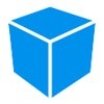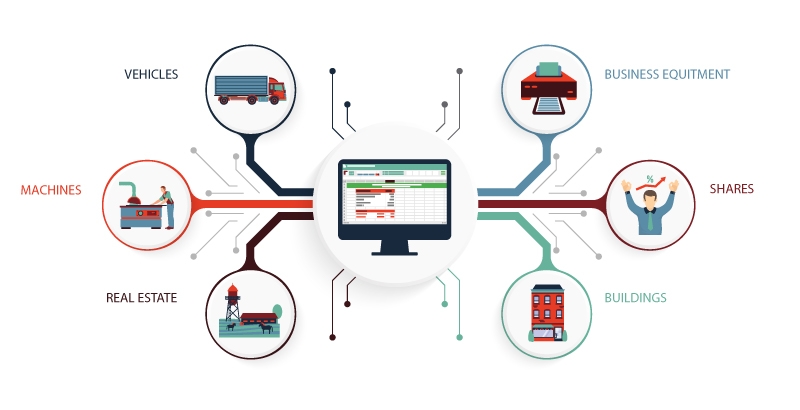Software Tips
What is asset accounting?
Asset accounting is a subarea of financial accounting. It deals with the management and posting of a company's long-lived assets. The company's own tangible assets such as land, buildings, machinery, office equipment, company cars, but also licenses, concessions as well as financial assets such as shares, participations, etc. are regarded as fixed assets.
Asset accounting records the acquisition value, production costs, acquisition date, depreciation amounts and useful life in the asset register. Basic inventories can be created on the basis of the asset register. Fixed asset accounting determines imputed, tax and balance sheet depreciation. Depreciation can reduce the company's taxable profit, which can have a positive effect on the tax burden. The monetary amount by which an asset is depreciated each year depends on the type of asset and its acquisition value. Generally, low-value assets are not included in the asset register.
Asset accounting software is often offered as a module to complement or extend financial accounting software. However, asset accounting software is also available as standalone software from various vendors.
Important elements of an asset accounting software
Asset Master Data Management
 Typically, the following asset information is maintained in Asset Master Data Management: Asset number, asset name, acquisition date, acquisition cost, depreciation, net book value, location. The respective master data record of an asset corresponds to a conventional inventory card of an asset file. The totality of all master data records corresponds to the asset card index.
Typically, the following asset information is maintained in Asset Master Data Management: Asset number, asset name, acquisition date, acquisition cost, depreciation, net book value, location. The respective master data record of an asset corresponds to a conventional inventory card of an asset file. The totality of all master data records corresponds to the asset card index.
Asset history sheet
 An asset history sheet is an overview of a company's fixed assets, showing the development of each individual asset in terms of value. The fixed asset grid is a supplement or extension of the annual balance sheet and the income statement. Each asset has its own item in the fixed asset movement schedule. The structure of the fixed asset movement schedule is regulated in the German Commercial Code § 284 para. 3 HGB. It may be helpful to be able to output and print the fixed asset movement schedule in different report formats.
An asset history sheet is an overview of a company's fixed assets, showing the development of each individual asset in terms of value. The fixed asset grid is a supplement or extension of the annual balance sheet and the income statement. Each asset has its own item in the fixed asset movement schedule. The structure of the fixed asset movement schedule is regulated in the German Commercial Code § 284 para. 3 HGB. It may be helpful to be able to output and print the fixed asset movement schedule in different report formats.
Example of a plant grid
| Asset |
Acquisition or production costs |
Additions in the financial year |
Disposals in the financial year |
| Transfers of the fiscal year |
Write-ups of the fiscal year |
Depreciation (accumulated) |
Carrying amount |
Depreciation methods
 There are various depreciation methods. These include straight-line, declining-balance, progressive and fractional depreciation, as well as depreciation by output. Which of these methods is allowed for which assets as tax depreciation methods is regulated by law. Asset accounting software should therefore always take into account current tax legislation.
There are various depreciation methods. These include straight-line, declining-balance, progressive and fractional depreciation, as well as depreciation by output. Which of these methods is allowed for which assets as tax depreciation methods is regulated by law. Asset accounting software should therefore always take into account current tax legislation.
Interface to financial accounting
 An interface from fixed asset accounting to financial accounting enables seamless transfer of data, thus avoiding duplicate accounting and improving accounting accuracy. The consistency of accounting and valuations is ensured and the management of fixed assets can be done directly in the accounting. There is no need to change the program.
An interface from fixed asset accounting to financial accounting enables seamless transfer of data, thus avoiding duplicate accounting and improving accounting accuracy. The consistency of accounting and valuations is ensured and the management of fixed assets can be done directly in the accounting. There is no need to change the program.
Reports and evaluations
 As a rule, the asset accounting software includes a number of different options for reports and analyses. These can include reports on asset additions, cost reconciliations and overviews of fixed capital, as well as analysis reports on depreciation, etc. These reports and analyses can usually also be generated during the year and thus support planning and business decisions.
As a rule, the asset accounting software includes a number of different options for reports and analyses. These can include reports on asset additions, cost reconciliations and overviews of fixed capital, as well as analysis reports on depreciation, etc. These reports and analyses can usually also be generated during the year and thus support planning and business decisions.
Advantages of using asset accounting software
The use of digital asset accounting software usually leads to time savings and, as a result, cost savings. Asset accounting software assists with asset management, depreciation, asset valuation, asset posting and listing, or asset grid. Better organization and a high degree of automation result in efficiency gains in the management of fixed assets, the determination and posting of depreciation, and the reconciliation and exchange of data between asset accounting and financial accounting. It also facilitates the balancing of fixed assets and controlling. During the year-end closing process, data can generally be exchanged directly and without media discontinuity between asset accounting and financial accounting via interfaces.
Tips and question suggestions
Further specific criteria and question suggestions for the evaluation of software for asset accounting
- Before making a software decision, conduct a thorough market research of potentially suitable solutions. Our tip: Use our free research service without any obligation. Large parts of the tender are taken over, potential solutions are presented in a structured way and the communication with the providers is documented!
- Also look for a clear program interface, convenient entry aids and input masks, as well as additional booking and help wizards.
- Check if the asset accounting software also maps management options and mapping capabilities of sales.
- What inventory support features does the fixed asset accounting software provide?
- Clarify whether the inventory no., serial no., a device designation and a barcode are printed during label printing.
- Ask whether it is also possible to check the current market value of the asset in the case of so-called private withdrawals. It should also be possible to manage the account to which the current market value is attributed.
- Also check the possibility of automatic determination of depreciation accounts e.g. the account to which the net book value is posted. This account should be able to be determined automatically by the program. A manual selection option of the respective account should of course also be available.
- Also review options for separations due to, for example, scrapping and accident.
- Note that memo values should be depreciated and processed correctly.
For example, if you previously carried an asset with a memo value and it has now been retired from the business, you can write off the net book value after the period of scheduled depreciation. The asset is then no longer managed in the fixed asset movement schedule.
- Ask if repair costs and new acquisition costs can be contrasted to analyze cost effectiveness or make decisions.
- Check whether resubmission functions are available for appointments, e.g. maintenance appointments.
- Does the provider offer a demo version for testing? Does this demo version have the full range of functions?
- When choosing a software for asset accounting, make sure that the provider offers regular updates so that the software is always up to date with the latest legislation.
- Does the asset accounting software include the integration of the depreciation tables?
- When selecting the software, pay attention to whether the scope of functions includes the backup of business data! Are the current standards taken into account when backing up the data? Does an audit-proof archiving of the business data take place?
 Asset inventory - inventory software - inventory management with barcode and RFID - inventory execution. Interfaces to SAP, Diamant R/3, UNIT4, DATEV, Wilken, Entire, HIS, ProAlpha, Infor, Schleupen, MACH, NAVISION, Oracle, Sage, Orbis and many more. Parsec.NET ensures a resource-saving and comfortable administration of your systems in compliance with legal regulations.
Asset inventory - inventory software - inventory management with barcode and RFID - inventory execution. Interfaces to SAP, Diamant R/3, UNIT4, DATEV, Wilken, Entire, HIS, ProAlpha, Infor, Schleupen, MACH, NAVISION, Oracle, Sage, Orbis and many more. Parsec.NET ensures a resource-saving and comfortable administration of your systems in compliance with legal regulations. Thanks to the integrated interfaces to financial accounting, the seventhings software provides a good basis for always supplying asset accounting with up-to-date information about the inventory. Since all information about the assets and the rest of the inventory is available on one platform, the processes in asset accounting are also significantly optimized.
Thanks to the integrated interfaces to financial accounting, the seventhings software provides a good basis for always supplying asset accounting with up-to-date information about the inventory. Since all information about the assets and the rest of the inventory is available on one platform, the processes in asset accounting are also significantly optimized.